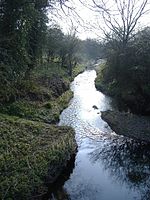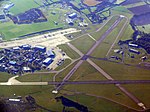Dauntsey

Dauntsey is a small village and civil parish in the county of Wiltshire, England. It gives its name to the Dauntsey Vale in which it lies and takes its name from Saxon for Dantes- eig, or Dante's island. It is set on slightly higher ground in the flood plain of the upper Bristol Avon. Today, the parish is split by the M4 motorway, with a chain of historic smaller settlements spread either side. Dauntsey Green is north of the motorway, along with Dauntsey Church at the entrance to Dauntsey Park; to the south are Greenman's Lane, Sodom and Dauntsey Lock. Dauntsey Lock is on the former Wilts and Berks Canal (presently being restored), the course of which runs alongside the Bristol-London mainline railway.
Excerpt from the Wikipedia article Dauntsey (License: CC BY-SA 3.0, Authors, Images).Dauntsey
Church Lane,
Geographical coordinates (GPS) Address Nearby Places Show on map
Geographical coordinates (GPS)
| Latitude | Longitude |
|---|---|
| N 51.536 ° | E -2.011 ° |
Address
Church Lane
Church Lane
SN15 4HW , Dauntsey
England, United Kingdom
Open on Google Maps







